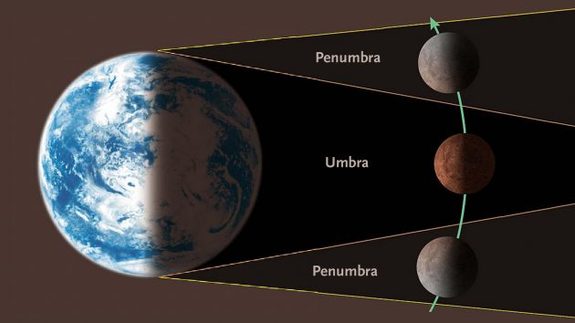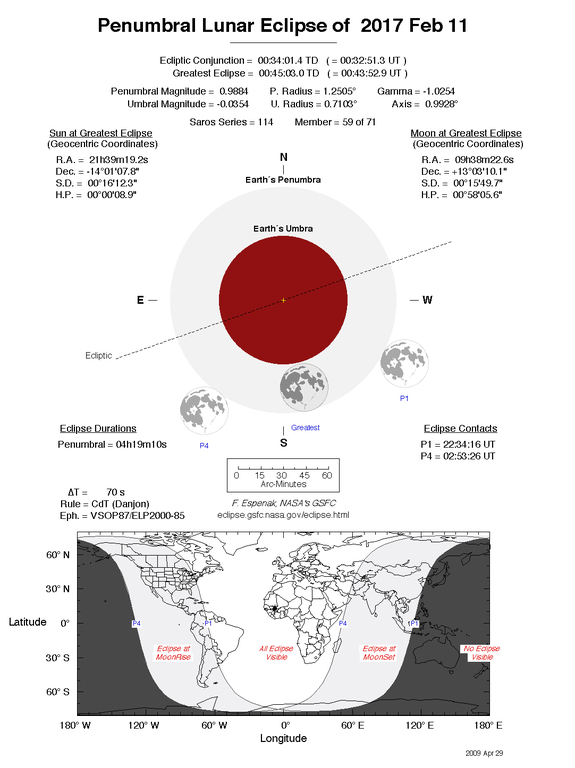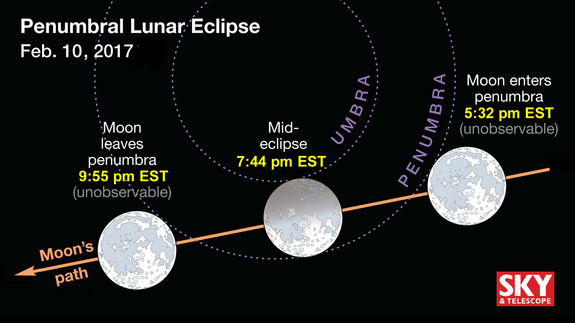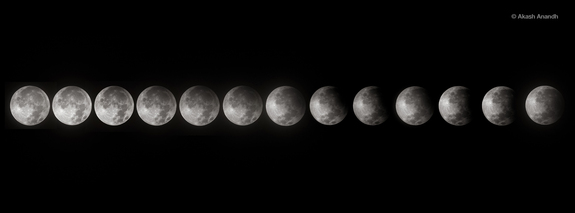Featured Post
- Get link
- X
- Other Apps

An astronaut standing on the moon when it's in Earth's penumbra would see the sun only partly hidden by Earth but completely covered from locations within the umbra. (Illustration not to scale.)
Credit: Sky & Telescope illustration
February's Snow Moon will be no ordinary full moon for skywatchers in most parts of the world, as it coincides with a special lunar eclipse that will cast a shadow over the full moon's usual bright, glowing face.
On Friday (Feb. 10), just 10 minutes after the full moon peaks, so will a penumbral lunar eclipse. The moon will spend more than 4 hours coasting through Earth's outer shadow, called the penumbra, and it will appear darker than normal.
While penumbral eclipses can be difficult to see and don't look nearly as dramatic as a total lunar eclipse — in which the moon passes through the darkest, central part of Earth's shadow — Friday's penumbral eclipse will be darker and more noticeable than most lunar eclipses of its kind. That's because the moon will veer so deeply into Earth's penumbral shadow that it will be almost entirely submerged in shade.
Where to see it
Friday's penumbral lunar eclipse will be visible from most countries of the world, with the exception of Australia, New Zealand and the East Asian countries along the Pacific coast. In the U.S., the state of Hawaii will miss out on the event.
Skywatchers across Europe, Asia, Africa and North America will all be able to see the lunar eclipse, though some regions will have a better view than others. The best places to see the eclipse from beginning to end are Europe, Africa and the eastern side of South America (including most of Brazil).

Diagram illustrating the penumbral lunar eclipse of Feb. 11, 2017
Credit: Fred Espenak/NASA
Noah Petro, a research scientist for NASA's Lunar Reconnaissance Orbiter at NASA's Goddard Space Flight Center, told Space.com that the best place in the world to see this eclipse would be "on a cruise ship in the middle of the Atlantic Ocean." But a boat is certainly not required to appreciate the sight of this subtle lunar eclipse.
When to see it
The moon will first enter Earth's shadow at 5:32 p.m. EST (2232 GMT), and its moonlight will slowly but surely grow dimmer for a little over 2 hours. After the eclipse peaks at 7:43 p.m. EST (0034 GMT on Feb. 11), the bright glow of the full moon will take about another 2 hours to return to normal. The moon will be completely outside of the penumbral shadow by 9:55 p.m. EST (0255 GMT on Feb. 11).

During the lunar eclipse on Feb. 10-11, the moon skirts just outside Earth's dark umbra. Look for deep penumbral shading on the north half of the lunar disk.
Credit: Sky & Telescope diagram
In most of North America and the western half of South America, the eclipse will peak while the full moon is still rising. Viewers in the Midwest and in the Pacific states may miss the beginning of the eclipse, as the moon will rise close to the horizon around the same time as the sunset. Observers in East Asia will encounter a similar scenario, because the eclipse will be at its maximum at the time the moon is setting (and the sun is rising).
Regardless of where you are watching it, the first and last 40 or so minutes of the eclipse will probably not be noticeable, Sky & Telescope senior editor Alan MacRobert said in a statement. "The outer part of Earth's penumbra is so pale that you won’t notice anything until the moon's edge has slid at least halfway in," MacRobert said, "so start looking about 90 minutes before mid-eclipse."
How to see it
Although the penumbral lunar eclipse is a 4-hour-long event, its effect won't be noticeable that entire time. The moon will appear darkest when the eclipse is at its maximum at 7:43 p.m. EST (0034 GMT on Feb. 11).
Because the eclipse happens in slow motion, its darkened tone might not be so obvious. "You might be able to notice that the moon looks a little weird" if you go outside and look just once, Petro said, but "it's best to go out and look periodically as the eclipse unfolds." Better yet — stay outside the entire time to take photos of the moon intermittently so you can compare them later, Petro added. [Moon Photography Tips from Astrophotographers: A Visual Guide]

This image taken by Akash Anandh in Singapore shows the varying shadows cast over the moon during the penumbral lunar eclipse on Sept. 16, 2016.
Credit: Akash Anandh
As with most skywatching events, it's best to be mindful of light pollution and other aspects of your surroundings that could hinder the view, such as tall mountains, buildings and trees, Petro said. For viewers in the western half of the Americas, in particular, where the eclipse occurs as the moon is low on the horizon, tall objects could block your view of the moon. Clouds that get in the way may also make it difficult to notice any changes to the moon during the eclipse.
To observe Friday's eclipse from North or South America during moonrise, look toward the eastern horizon to find the moon. If you're having trouble locating the moon or don't know what time the moon rises at your location, you could try using a mobile stargazing app. Or you can simply type "moonrise" and your location into a Google search.
Petro recommends going outside for a "practice run" about 24 hours in advance to locate the moon and determine the best spot for your lunar observations. "Use that opportunity to start looking at and paying attention to the moon," he said.
Moon Master: An Easy Quiz for Lunatics
For most of human history, the moon was largely a mystery. It spawned awe and fear and to this day is the source of myth and legend. But today we know a lot about our favorite natural satellite. Do you?
0 of 10 questions complete
What's a Snow Moon?
Every month's full moon has at least one nickname that can be traced back centuries to Native American tribes. February's full moon was appropriately dubbed the Snow Moon, because this month typically sees the heaviest snowfall of the year. Some tribes have also called it the Hunger Moon as the winter weather made it difficult to hunt and forage for food. [From Lunar Wolves to Worms, These Are the Full Moon Names of 2017]
Editor's note: If you capture an amazing photo of the penumbral lunar eclipse and want to share it with Space.com for a story or gallery, send images and comments in to managing editor Tariq Malik at spacephotos@space.com.
Email Hanneke Weitering at hweitering@space.com or follow her @hannekescience. Follow us @Spacedotcom, Facebook and Google+. Original article on Space.com.
EDITOR'S RECOMMENDATIONS
- sSource: Hanneke Weitering, Staff Writer-Producer - Space
Comments